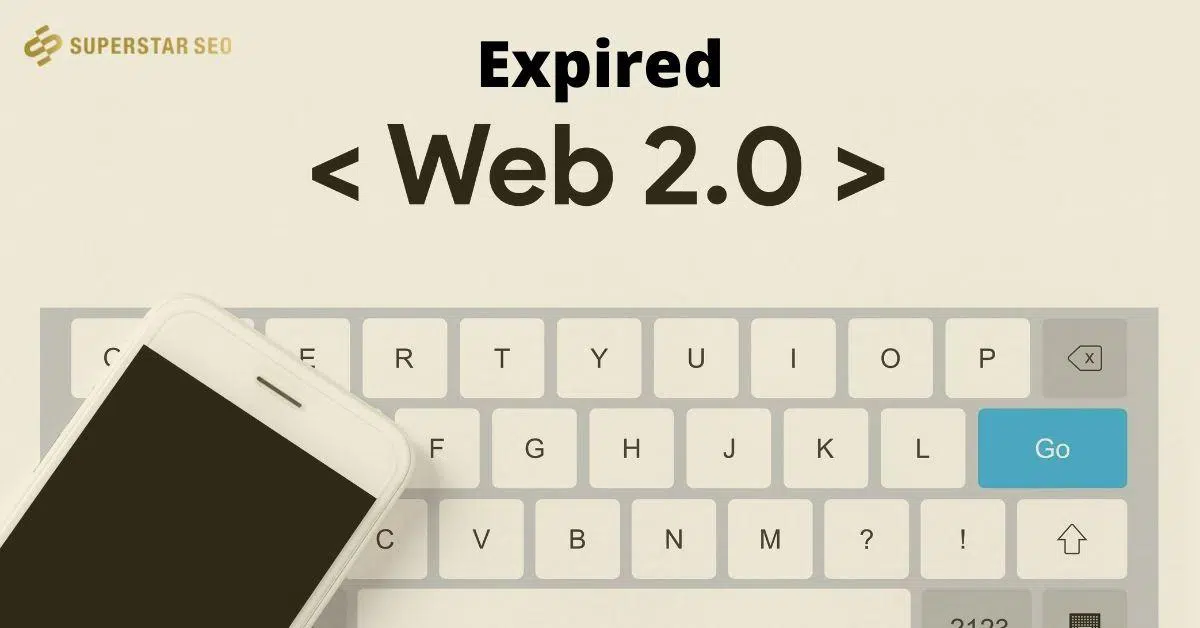SEO success is about thinking outside the box, finding the grey areas in Google’s rules, and using them to the best of your advantage. And one way to do so is by building a private blog network (PBN).
There are several ways you can build a PBN for your money site. Some people will start and grow new blogs from the bottom, while others will find expired domains. In between, there exists a simpler and cheaper approach; to find expired Web 2.0.
What are expired web 2.0 sites?

Source: Canva Pro
Web 2.0 websites allow anyone to create and share content. They include Tumblr, Youtube, MySpace, Flickr, Wikipedia, Weebly, WordPress, Blogger, and social media sites like Facebook and Twitter. Content and podcast hosting websites also count as web 2.0.
Expired web 2.0 sites have been de-registered from the platform for one reason or another. Fortunately, some SEO geniuses realized that these are not completely useless and can, in fact, be used to boost a website’s search engine rankings.
That’s why finding expired web 2.0 sites has become some sort of a big deal.
Why do expired web 2.0 sites matter?
Backlinks, of course. Anything in SEO that connects multiple sites is all about backlinks.
Imagine a casual blogger with a WordPress personal blog, nicebooks.wordpress.com. The site may be small, but getting a link from it may help an affiliate or e-commerce domain selling books.
It would be even better if the domain could get more links from the blog or create a network with similar blogs in the niche. But this requires a lot of pitching, and they may have to pay the bloggers for each link they get.
Individual web 2.0 sites don’t usually have a lot of authority and are certainly not worth paying for. Thus, paying two dozen wordpress.com bloggers $50 each would be the wrong approach.
In comes expired web 2.0 sites
Finding existing websites willing to link to your money site isn’t easy. Of course, you can always create your own web 2.0 sites, but that’s even harder and takes longer to show results. That’s where expired web 2.0 sites come in.
These websites have been around for a while and have gathered some decent page authority and trust flow. But since they have been de-registered, they’re inactive and don’t exactly have an owner. Fortunately, some platforms, like Tumblr and Weebly, allow you to activate and re-register expired web 2.0 sites for free.
Once re-registered, they can be linked back to a money site to create a PBN. If they have a high page authority and trust flow, these links will have higher credibility in search engines. The money site will then benefit from the SEO juice, ranking higher in search engine result pages.
Sounds great. But first, you need to find the web 2.0 sites.
How to find expired web 2.0

Source: Canva Pro
To find expired web 2.0 blogs, you need to set up ScrapeBox and install the addons ScrapeBox Vanity name checker and ScrapeBox Page Authority. Both add-ons are free, but ScrapeBox costs a one-time fee of $67 to get a single PC license. You’ll also need seo Moz, a list of keywords, and proxies.
Scrapebox will help you find WordPress, LiveJournal, Tumblr, Wikidot, Blogpost, Overblog, and other web 2.0 sites. Of these, WordPress will stop you from registering previously used names. LiveJournal will also cost you $15 to rename an expired account. Thus, WordPress and LiveJournal sites are unpopular among expired web 2.0 sites for PBN.
Most people will go for Tumblr, Blogpost, and Overblog. The process of scraping these web 2.0’s is similar across all sites. Overall though, it’s pretty easy. The only thing you have to be is patient.
Step 1: Deciding the web 2.0 profiles to harvest
Once you have all the add ons installed, it’s time to find the web 2.0 profiles to check. To do this, open the Vanity Name Checker. This add-on will check web 2.0 profiles to see which ones are available for registering, but for now, click on Settings to reveal a list of the sites supported by Scrapebox. We will be using Tumblr for our illustration, but you can pick any platform because the process is more or less the same.
You’ll now close Vanity Name Checker and open Scrapebox; specifically, the “Harvester.” While on Harvester, click “Custom Footprint” (sometimes it will be already selected) and then type in “site:tumblr.com.” This will instruct the tool to scrape site URLs with the domain “tumblr.com.”
Step 2: The keywords
The next thing you need is keywords. You can do a google search to find general keywords or use a keyword scraper tool to generate a list of keywords relevant to the niche of your money site. The length of this list depends on your niche.
Now, take these keywords and paste them into your Scrapebox Harvester.
Step 3: Proxies and the search engine
You also have to select the search engine you want to scrape. This should always be Google since it is the best and most popular search engine for SEO. And if you’re using more than 100 keywords to harvest, you’ll want to use at least 30 proxies.
Using proxies is important because every IP address has a rate limit. Since scraping many keywords will send multiple requests from your IP address, Google will notice, realize that you’re scraping the web, and block your cache.
Proxy servers will spread your requests across several IPs. So, Google will see several requests coming from different servers. And if you’re using enough proxies for your keywords, all the requests from your IPs will stay within Google’s request limit. That way, the search engine won’t realize that you’re scraping for URLs.
Step 4: Scrape your way
With the keywords and proxies in place, click on the M button and select “Custom Footprint.” You’re now ready to scrape for web 2.0 URLs. Click on the “Start Harvesting” button and wait.
The scrapping process will take a couple of dozen minutes to go through all your keywords. You can also stop the process once you see that you’ve gotten enough sites. Usually, you’ll end up with thousands of web 2.0 URLs depending on your keyword list and the platform(s) you selected.
Step 5: Checking for the URLs availability
A significant portion of the URLs you discover will be duplicated. This is because some sites pop up hundreds of times when you scrape. But you only want unique Tumblr profiles, so you’ll have to remove these duplicates.
Go to “Manage Lists” and click on the “Remove/Filter” button. You’ll see options to remove duplicate URLs and Domains. Select these, and it should greatly reduce the number of web 2.0 domains on your list. You’ll also need to “Trim to Root.”
Now that you only have unique profiles, you want to check which ones are available. For this, open the Vanity Name Checker Scrapebox addon and paste all the web 2.0 URLs into the “Keywords/Urls” field.
Tick the small “urls” checkbox at the bottom of the addon and on the settings tab, make sure that only URLs from web 2.0 sites you harvested are checked. In our case, we’re using Tumblr, so we will uncheck everything else.
Select the number of threads you want and let the add-on run. Depending on the number of imported URLs, the process will take minutes to complete. It will show you the available profiles, those taken, and those with a socket error. We want the available ones.
Now, click on the “Export” button and select “Export sites available text.” Save them the available web 2.0 profiles. You can now go ahead to filter and choose the sites that will best serve your PBN.
Step 6: Filter by PA and PR
Although page rank (PR) is no longer a great indicator of SEO juice, you should always check it. For this, go to “URLs Harvested” on Scrapebox and import the txt file with the harvested URLs. Next, click on “Check Pagerank” and select “Get URL Pagerank.” A Tumblr profile with a page rank will be nice for your PBN.
Go ahead to Moz and open their page authority (PA) addon. Load the txt file with the expired web 2.0 URLs and click start. The add-on will take an hour or two to go through all the URLs and show you their page authority. Don’t focus on the domain authority (DA) because it’s for the domain “tumblr.com” and will be the same for all expired Web 2.0 accounts.
Web 2.0 profiles with a PA of 30 and above are relatively great. So take your pick, register them, and you can start building your PBN.
Is there any other way to find web 2.0?
Yes. If you want to avoid the hassle of scraping, ranking, and filtering web 2.0 profiles, you can buy them on Legiit. There are many SEO freelancers on Legiit selling high PA expired web 2.0 sites that should help your money site rank higher.
You can also use paid software like Domain Hunter Gatherer to find web 2.0 sites. All you have to do is enter your keyword, and the tool will list all the expired web 2.0 profiles that match your keywords.
Benefits of using expired web 2.0 links

Using expired web 2.0 sites for your PBN comes with several advantages. The biggest of these is that you have complete control over your network. You get to create the entire thing, select what sites go into your network, and decide which links go where. You can also add and remove links to your money site and optimize the content however you want.
Speaking of content, generating it for your web 2.0 sites isn’t that hard. Some platforms, like Tumblr, only require you to share the bare minimum. A photo, quote, or video with a caption linking to your money site will work just fine. Other sites will require you to write up some content, but this isn’t as demanding as running an actual domain.
Using backlinks from web 2.0 sites also doesn’t violate Google’s policies. So, you’re safe from having your PBN disrupted by the search engine even though John Mueller, a Webmaster Trends Analyst at Google, categorized such links as spammy. To be fair, he wasn’t completely wrong. Backlinks from web 2.0 sites can appear spammy, but only if you have too many of them on your money site.
Finally, web 2.0 backlinks can be the most cost-effective option out there. They are cheaper than expired domains and don’t require as much effort and care to set up. In addition, you don’t have to pay to register or buy multiple hosting accounts with web 2.0’s. So, whether you purchase the sites or scrap them yourself, you can be sure that you are getting a bang for your buck.
You May Also Like: How To Find Expired Domains For PBN
Final thoughts
Finding web 2.0 sites is the easiest and most affordable way to build a PBN. You can scrap for them, have a paid software do it for you, or buy from freelancers on platforms like Legiit.





